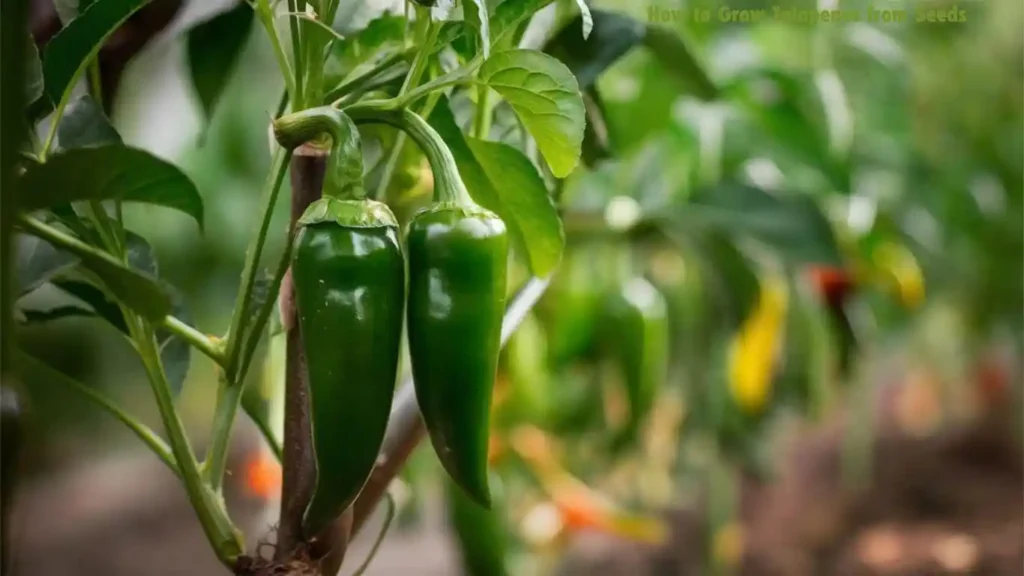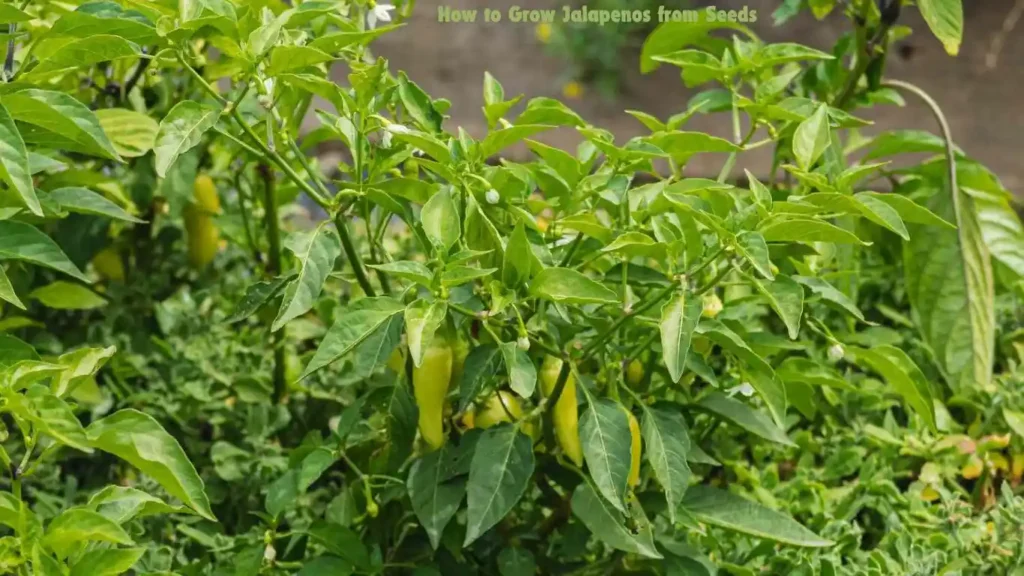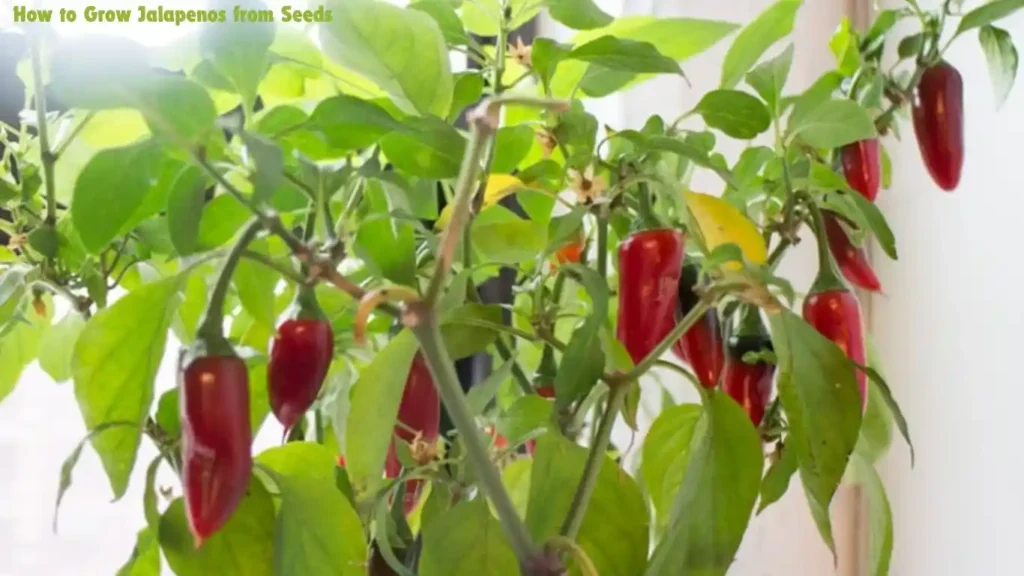How to Grow Jalapenos from Seeds Care, Types & Diseases
Jalapeños are a staple to have in one’s kitchen for anyone who wishes to add a little spice to his or her cooking.
Whether you are an experienced gardener, who simply loves caring for plants or a newcomer who wants to grow something unique and delicious, it is rather fascinating and rather easy to plant jalapeños from seeds.
Here in this guide, we’ll explore everything you need to know about raising jalapeño peppers – from sowing the seeds to harvesting the fruits. Let’s dive in!
The Importance of Jalapeños
Did you know that How to Grow Jalapenos from Seeds are more than just peppers to add a little kick to your meals? These delicious babies contain vitamin C and antioxidants!
They add an exotic taste and a spicy kick to almost any type of meal preparation which includes salsa and stir fry.

How to Grow Jalapenos from Seeds peppers are quite easy to grow, especially for those who enjoy cooking since this way you always have fresh peppers.
Growing from Seeds: An overview
Jalapeños grown from seeds is quite different from the rest, here are some things you will encounter.
You start from the beginning and nurture the plant right from the time of germination; you get even more content when the plant is finally grown.
It is not very difficult, but it can be a bit time-consuming if you pay too much attention to details.
It is possible to cultivate jalapeño plants that do well in your yard or pots if you try this procedure.
Plant Attributes
Originally, jalapeños are part of the Capsicum annuum species and according to their Scoville heat measurement, the jalapeño is rated between 2,500 and 8,000.
It can reach a maximum of 2-3 feet tall, the skin of the fruit is shiny and firm with green color turning to red when they ripe.
Characteristics of Jalapeño Plants
How to Grow Jalapenos from Seeds have a tender perENNIAL growing habit commonly referred to as a bush, and the foliage is of medium to dark green color.
They offer large, thick-walled medium types that are well suited to grilling, stuffing, or for use in spicy dishes. These plants require warmth with sun concentration for them to grow and give the best yields.
Why should you grow your own jalapeños?
This is especially so when you’re growing your own jalapeños; it gives you the freshest produce that you can get.
And on top of it all, there is the added pleasure of seeing your plants grow. Growing jalapeño at home gives you a better taste as compared to buying it from local stores.
you are able to control the medium in which the jalapeño is grown making it organic and free from pesticides.
Jalapeño Care
Maintaining jalapeño plants in good health is important in ensuring that one gets a good yield of the plant in his or her garden. So it will be time to unwind the basics.
Light Requirements
How to Grow Jalapenos from Seeds Plants require sunlight to grow and therefore they should be exposed to light at least 6-8 hours a day.
If there is a shortage of light the plants develop a more erect growth habit or become ‘leggy’ and the ultimate yield of peppers may be reduced.
Soil Preparation
It is recommended that the planting area should be dug and incorporated with organic matter such as compost and manure. Jalapeños grow best in soil that drains well and has a pH, of 6. 0 and 6. 8.
Watering Schedule
Watering should be done regularly especially when growing jalapeños from seeds. The plants should be watered thoroughly but the soil should not be left to dry up too much before they are watered again.

It should be noted that overwatering causes root rot while underwatering the plant may also stress it.
Temperature and Humidity Control
How to Grow Jalapenos from Seeds do not like cold climates or rather, they do very well under hot climates. It is preferred that the temperature range be between 70°F to 85°F (21°C to 29°C).
Associated with diseases are high humidity levels thus ensuring free air movements in the plants.
Fertilizing Your Plants
A balanced fertilizer should be applied to the plants during the growth period to enhance the growth of the plants.
A 10-10-10 fertilizer is effective but should not be overused because while encouraging the growth of the foliage it hinders the fruits from sprouting.
Pollination Techniques
Jalapeños flowers are self-limbed but a little agitation of the plants assists in the pollination process and this is easily done through agitation, particularly in low wind regions and even indoors.
Types of Jalapeño Peppers
How to Grow Jalapenos from Seeds has widely been categorized into different varieties; these are however characterized by different qualities. Here are a few to consider: Here are a few to consider:
Varieties and Their Characteristics
Early Jalapeño: Matures faster for short growing seasons, and performs well in short growing seasons.
Purple Jalapeño: Bush starts at purple and then turns red when ripe.
Jalapeño M: It is proven to be the most popular type of chili thanks to its moderate level of spiciness.
How to Grow Jalapenos from Seeds are objectified with other mild hot peppers like serrano peppers. Serrano peppers are equally as spicy as habanero, only they are hotter.
On the other hand, Jalapeños are thick-skinned and relatively mild, thus more suited for culinary purposes.
Planting Jalapeño Peppers
Well, now that I have informed you what jalapeños are all about, it is time to know how to plant them.
When to Plant
Begin seeds in trays or pots inside approximately 6-8 weeks before the time of the last forecasted frost in the locality.
How to Grow Jalapenos from Seeds have to be planted in warm soil hence it is advisable to transplant the seedlings once the danger of frost is out of the picture.
Selecting a Planting Site
It is preferably grown in a sunny area with a good drainage system to avoid water logging.
The containers that you are using for the growth of your indoor plants should be adequately large enough for the plant to grow in.
Spacing, Depth, and Support
To plant Marigold seeds, it is recommended that they be planted about ¼ inches beneath the soil.
Once the plants are transplanted, they should be planted about 12-18 inches in between one another.
Stakes or cages should be used to support the plants especially when they grow and develop fruits that may spoil the plant.
Planting from seeds is one of the common ways that most people use in planting, and in this section, we will be learning how to plant from seeds.

Planting from seeds is simple: Sow the seeds in seed-growing trays that have suitable potting soil.
The seeds should germinate within the period of 10-14 days if the soil is moist and warm (about 75 °F).
Growing Jalapeños from Seed
Once the seeds have germinated, it’s time to look after your seedlings and make sure they turn into strong plants.
Seed Germination
How to Grow Jalapenos from Seeds Seeds require heat in order to germinate. It is recommended to use a heating mat especially if you are trying to encourage germination to happen at the right temperature.
When transplanting, ensure the seedlings are taken to a well-lit area of the room or whatever area that you will be growing the plant.
Transplanting Seedlings
When it has 2-3 leaves the seedling can be transplanted on the ground or on a larger pot.
Make sure to take time to bring the plants under the conditions in the outside environment for about a week for hardening off.
Potting and Repotting Jalapeños
Choosing Containers
Pots that are to be used to grow jalapeños should be at least 12 inches deep so as to accommodate the roots.
When and how to report is an important decision that must be made wisely so that the plant will not suffer from the process.
If your plant has grown too big for the pot it is in, then, very gently transfer it to a bigger pot.
Make sure that the new pot has drainage holes on it and it is not important to uproot the plant when repotting it.
Pruning and Propagation
Benefits of Pruning
Pinching your jalapeño plants stimulates more branching and also provides enough space between the plants reducing instances of diseases.
Backyard Gardening 22: How to Prune Jalapeño Plants
Trim the young, trailing branches and leaves particularly those leaves and stems that are touching the ground to minimize pests and diseases.
Methods of Propagating Jalapeños
How to Grow Jalapenos from Seeds can be propagated in two ways; through seed planting or through stem cutting by placing the stem in a glass of water or in a pot of soil.
Overwintering Jalapeño Plants
Caring for plants during winter or any freezing condition is a very crucial aspect to consider so as to enhance the well-being of the plants.
Of course, if your climate is severely cold during the winter, then you should be sure to move your jalapeño plants inside before the frost.
Indoor Care During Winter
Put the plants in a sunny window and water them less often. They can be placed inactive in the winter but will bloom again when put back under warm weather conditions outside.
Common Pests and Plant Diseases
Identifying Pests
Aphids, spider mites, and whiteflies are common pests that can affect jalapeño plants. Inspect your plants regularly and use insecticidal soap if necessary.
Disease Prevention and Treatment
To prevent diseases, avoid overhead watering and ensure good air circulation around your plants. Common diseases include blossom-end rot and bacterial leaf spot.
Common Problems with Jalapeños
Here are a few issues you might encounter while growing jalapeños:
Sunken Spots on Fruit
This is often a sign of blossom-end rot, caused by calcium deficiency or inconsistent watering.
Scalded Fruit
This can happen if your peppers are exposed to too much direct sunlight. Provide some shade during the hottest parts of the day.
Yellow Leaves
Yellow leaves can indicate overwatering, nutrient deficiencies, or pest problems.
Harvesting Jalapeño Peppers
When to Harvest
How to Grow Jalapenos from Seeds are ready to harvest when they are firm and green, but you can also wait until they turn red for a sweeter flavor.
Harvesting Techniques
Use pruning shears to cut the peppers from the plant, being careful not to damage the stem.
Growing Jalapeños in Pots
Benefits of Container Growing
Container gardening allows you to control the growing conditions more easily, especially in areas with unpredictable weather.
Best Practices for Pot Cultivation
Ensure your pots have good drainage, use high-quality potting soil, and fertilize regularly for the best results.
Conclusion
How to Grow Jalapenos from Seeds can easily be grown from seeds an activity that will improve your garden and of course the meals you prepare.
If the plants are well taken care of they will grow and yield you good produce. All they need is light, heat and affection remember that Light – Heat – Affection!
FAQS
Should you soak jalapeno seeds before planting?
Although it is not very important, the pepper seeds should be presoaked so that they can begin germinating very quickly. Soak pepper seeds in a bowl or jar of water at room temperature for not more than 24 hours so that the outside layer of the seed is softened thereby breaking dormancy.
How many jalapeno seeds to plant per hole?
With a ¼-inch hole, put your seed and then sparingly apply some soil over it. It will also be important to note that labeling of each variety must also be done when planting. Based on the number of cells and seed varieties available it is possible to plant as many as 4 seeds of the same variety in a cell.
Can I plant jalapeño seeds directly in the ground?
Indeed, the pepper seeds can be sown directly into the soil if the climate is warm and if the growing zone is 9 or greater once the soil is warm.
How often should I water jalapeños?
The soil that jalapeño plants like is always moist but not soggy; when the plants are over-watered, the root dies. Try to water your plants only when the first inch of the soil is dry.
Is hydrogen peroxide good for pepper plants?
Hydrogen peroxide triggers the arsenal defense in pepper plants without stress to plants or any decrease in performance. The induction of the arsenal defense by hydrogen peroxide from the pepper prevents PepGMV infections.
Also Read
